By using the most advanced technology available, TSE (Turun Seudun Energiantuotanto Oy) strives to produce sustainable and cost effective heat and electricity solutions for Turku and the surrounding areas.
EXPERTS IN ENERGY
Turun Seudun Energiantuotanto Oy (TSE) was founded in 2001 with the sole purpose of building a new CCGT power plant in Naantali for the district heat production to service the Finnish city of Turku and the surrounding municipalities.
TSE combines local expertise in the energy sector and expert knowledge from the Nordic energy industry to ensure that the Turku region receives its basic heating systems in an economic, efficient and sustainable way.
In 2001, Finnish NG company Gasum had a plan to construct a natural gas pipeline from central Finland to the Turku area, designed mainly for industrial use and energy production. However, the plan was never realised at this time. In 2011, the decision was then made to merge base energy production of Turku Energia Oy and Fortum’s local power plant into one company – TSE Oy – where these production assets were transferred, and the dream of creating a sustainable way to meet the heating requirements of the Turku area were born.
Today, TSE has an annual turnover of €150 million, which promises to remain steady into the future. “The existing CHP-capacity at the Naantali coal fired power plant will be replaced with more sustainable forms of energy generation in the form of the new NA4 CHP project. This project has reached the engineering phase with process and layout design nearing completion. The project is running on schedule and we are due to start work on the site this year,” says TSE Managing Director Tapani Bastman.
The turnover becomes even more impressive when considering there are only two people who work for TSE, making the company one of the most outsourced in the world.
VARIED CLIMATE
Finland is a country of contrasts, not just in the geographical sense, but also in its climate. Temperatures during the year vary considerably from -30°C in winter and +30°C in the summer. This has a considerable impact upon the country’s energy usage. By using the most advanced technology available, the country and energy companies like TSE strive to produce as much electricity as possible while also generating heat for the population of Finland.
Even though the population density is low, Finland’s share of CHP-production is among the highest in Europe; last year reaching 28 percent of the total electricity consumption in the country and accounting for one third of power production. As a result, another of TSE’s goals is to commit to the use of local and other sustainable sources of energy as required by the changing market conditions and the growing concern for the environment.
The intensive energy usage is backed by a large share of renewable based energies including biofuels used for heating purposes. “The country has a long tradition of utilising wood as an energy resource. The share of hydro power is not as high as the neighbouring countries Sweden and Norway, which is just one of the reasons why CHP-production technology has been developed successfully for decades here,” comments Bastman.
UNIQUE ALLINACE MODEL
In order to complete the NA4 CHP project, TSE has opted to use an alliance model for all civil work and HVAC installations, which is a relatively new concept in Finland. “Our project is the first on an industrial scale in the country to be utilising this new approach for civil works,” says Bastman.
In an alliance contract model, a set of providers enters into a single arrangement with a CCG to deliver services. Commissioners and providers are legally bound together to deliver the specific contracted service, and to share risk and responsibility for meeting the agreed outcomes. As such, they should be incentivised to innovate and identify efficiencies across the system, rather than solely within their organisation.
Subsequently, the alliance is reliant on high levels of trust across its relationships. Members collectively govern the alliance through a leadership board with an agreed term of reference.
Accompanying this new way of managing services is TSE’s unique commitment to shareholders via an ‘open book plus fee’ principle. Bastman explains how this has a strong impact on the annual average prices of TSE’s products: “This requires a careful balance between prices and profit. A certain level of annual profit – or EBIT- can be estimated and agreed beforehand by owners during the budgeting procedure.”
ABOUT BIOFUEL
In essence, Biofuel is created based on different fractions of harvested wood (timber and fibrewood) which is chipped before transportation to a power plant, such as Naantali. Turun Seudun Energiantuotanto Oy plan to use different wood residuals from saw mills and a small amount of straw from nearby farmers.
“When the plant is fully operational, the percentage generated by biofuels will be between 30-40 percent, however we hope to increase the share of biofuels to 60-70 percent. The remaining share will be generated by coal or peat,” says Bastman.
The CFB-boiler (Circulating Fluidised Bed) itself has been designed to convert 100 percent biodegradable materials. Fuel oil (or later LNG as an option) will be the starting fuel for the boiler.
“The advantages of the CFB technology certainly outweigh its limitations. The process is very flexible for multi-fuel purposes and with the right investment in R&D, the technology is predicted to bring further benefits through economical usage of even more challenging forms of biofuels,” Bastman surmises.
OPTIMISATION
Key to success of Turun Seudun Energiantuotanto Oy in the last year has been optimising its current production capacities rather than competing and increasing capacity. “By this I mean we have to ensure that products are fully optimised and are able to cope with a variable heat load, while also taking into consideration the price of power and the competitiveness of our product on the open market.
“Our Naantali power plant, Oriketo bioboiler, waste boiler and heat pump units are a complex system for heat production and are challenging to optimise. We have developed our own program to optimise our systems on an hourly basis, taking into consideration estimated heat load, estimated fuel prices, estimated power price and energy taxation. Calculations are made each day and we found the most important areas to be the hourly DH-consumption and power price. However, fixed costs are an important issue too and a strict balance of tight cost control versus streamlining the O&M services is therefore another key component to our success,” Bastman states.
Not only have the facilities been optimised, but the company has found the strong support of its shareholders to be a big contributor to the HR and training side of the business. Due to the company’s role as a base energy producer for the local area, it is not possible for TSE to have any expansion plans. However, this results in a stronger focus on the timely delivery of projects while remaining within the budgeted cost.
This strategy is supported by TSE’s healthy relationship with Fortum Power and Heat, who own 49.5 percent of the company. The two companies work harmoniously together to agree targets for the coming year and TSE also outsources training via Fortum. “In my opinion, a long term partnership with yearly targets agreed upon together is vital to developing O&M functions and is a learning process in itself,”
Bastman adds.
With a target to boost the share of renewables from 12 percent up to 50 percent via its projects, TSE is on target to boost the total fuel consumption to 4,250 GWh at the Naantali power plant this year.



































